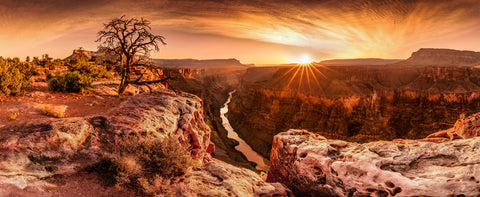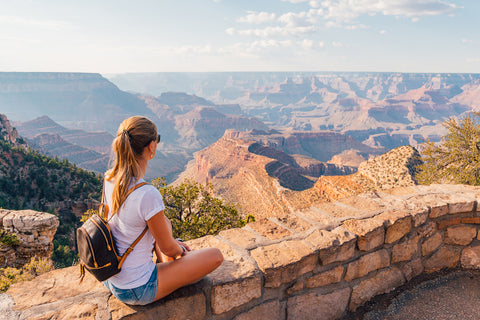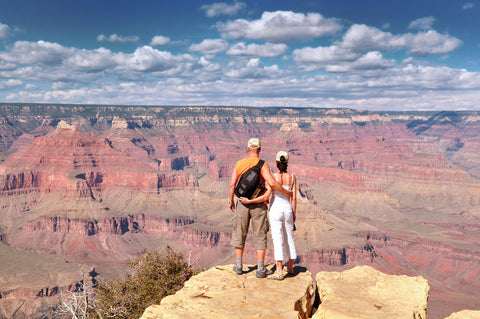Where is Grand Canyon National Park
The Grand Canyon is one of the most iconic places in the United States. It’s located in northern Arizona between the Vermilion Cliffs National Monument to the north and the Kaibab National Forest to the south. It’s situated on the southwestern portion of the Colorado Plateau, a desert area in the Four Corners region. The Colorado River cuts through the canyon. Phoenix, AZ is only 3 hours south of the Grand Canyon. The park is just a little over 4 hours from Las Vegas, NV.

How Big is Grand Canyon National Park
The Grand Canyon National Park is indeed grand - it stretches over more than 1,000,000 acres, covering nearly 2,000 square miles! The park is bigger than the state of Rhode Island. Though you can hike from one end of the Canyon to the other in about 20 miles, it takes about 220 miles to drive around the whole park. The canyon itself is over a mile deep. The South Rim’s elevation is 7,000 feet while the North Rim is 8,000 feet.
Grand Canyon National Park Weather
The canyon actually influences its own weather! Due to the mammoth elevation changes, the temperature and precipitation levels vary greatly. The North Rim reached –22 °F on February 1, 1985, the record low. Phantom Ranch gets the hottest, frequently hitting 120 °F during summer. Generally speaking, temperature decreases 5.5°F with each 1,000 foot elevation gain. At night, heat collected during the day is quickly lost and temperatures drop dramatically. In winter, snow falls on the rims but will melt before reaching the canyon. Winter and fall see the most precipitation. The wettest location is the North Rim. The months with the least precipitation are late spring and early summer. Lees Ferry is the driest area in the park.
When did Grand Canyon become a National Park
The Grand Canyon is over 6 million years old. However, it didn’t become a national park until February 26, 1919. Congress passed the bill that was signed by then-President Woodrow Wilson. Before it was a national park, former president Theodore Roosevelt made the area a Game Reserve in 1906. Two years later he declared the Grand Canyon a National Monument.

Things to do in Grand Canyon National Park
There is so much to see and enjoy at the Grand Canyon! Our National Park Visitors Guide highlights below some of the most popular activities and attractions available at the Grand Canyon National Park.
North Rim
The North Rim of the Grand Canyon is wild and remote. There are mules to ride, campsites to utilize, and Ranger Programs to join that teach about geology, animals and history. There are several hiking and biking trails, including Rainbow Rim and Bright Angel Point.
South Rim
For the best desert views, visit the South Rim. It features the Trail of Time near the Yavapai Museum of Geology, a path that highlights the canyon’s vast geological history. Bike along Hermit Road, take a helicopter tour or watch the Grand Canyon IMAX Movie.
Tusayan Pueblo
Three miles west of Desert View, you’ll find the Tusayan Ruins, also called the Tusayan Pueblo. The remains of the ancestral village are 800 years old. The U-shaped pueblo has a living area, storage rooms, and a kiva. The site also features a small museum.
Colorado River Rafting
Want a wet and wild time? There’s something for everyone on the Colorado River. Spend a half or full day on a float from Glen Canyon Dam to Lees Ferry. Take on white water rapids in the canyon, trips range from 3 to 21 days.
Desert View Drive
For sprawling scenic views of the Southwestern desert along the Grand Canyon, go on the Desert View Drive. You’ll leave Grand Canyon Village and head east 25 miles on State Route 64 to Desert View. There are rest areas and picnic spots along the way.
Mule Rides
List of Parks suggests taking a ride along the Grand Canyon in style on a mule. Mules are the safest way to traverse the canyon. Mule trips are offered year round. The Canyon Vistas ride takes you along the canyon rim in 3 hours. An Overnight ride takes you to the bottom of the canyon and you'll stay at Phantom Ranch.
Animals in the Grand Canyon
There are more than 600 different species that call this park home, including birds, mammals, reptiles, and amphibians. The Grand Canyon has one of the widest arrays of reptiles including gila monsters, chuckwallas and geckos. Endangered California Condors, Javelina, Ringtails and Bison are also present.
Geology
The Grand Canyon is a massive and magnificent geological wonder developed over millions of years. There are many interesting formations here, including the Dox, Toroweap, and Temple Butte Formations. The land here is constantly undergoing weathering and erosion, meaning the canyon will continue to change.Bicycling
Hitting the trails on two wheels is extremely popular at the Grand Canyon. They offer guided biking trails. Plus, Bright Angel Bicycles, near the Visitor Center, offers rentals on bikes. Bright Angel also features a coffee bar cafe with a menu for cyclists and hikers.
Hiking Trails
One of the best ways to take in the scenery and feel the size of the canyon is to go on a hike. North and South Rim both feature day hike trails. Backpacking trips require a permit. Overnight excursions include backcountry and deep canyon routes.

When to go to Grand Canyon National Park
You can visit the Grand Canyon year round. Some seasons are busier than others and the weather can vary. The most popular season for tourists at the US National Park is summertime. The temperatures are at their peak and the park is crowded. Spring and Fall are perfect weather and the crowds are thin. It is the best time to hike. The wildlife is the most active during these seasons; you’ll be more likely to spot condors and gila monsters. Spring through Fall you should make reservations. In winter, the weather can be rather chilly, with snow falling on the upper rims. There are less people visiting in winter. As such, there are some facilities that close in winter on South Rim.
Must-Have things to bring to Grand Canyon
When you’re exploring the Grand Canyon, there are a few essential items you should bring with you. For the safest, best experience you need the right tools for the trip:
Water
In the desert, water is essential. You’ll want to bring a bottle and some backups (or a large jug). A hydration filtration system is also recommended. Moving, sweating and the heat will add to your dehydration, so keep drinking water while you’re out and about!
Food/Snacks
Don’t forget to bring snacks for your journey to keep you fueled. While there are places to get food in the park, there are no canteens serving up grub on the trails. You can’t go wrong with foods like jerky, trail mix, fruit, and granola.
Park Maps (physical and on phone)
The Grand Canyon is massive. From the North Rim to the South Rim and the chasm in between, there are many trails and attractions. Grab a park map before your adventure. Having a copy on phone or GPS with directions is a good idea too.
Comfortable, Sturdy Shoes
When you hike around the Grand Canyon you’ll be stepping over hot sand and rugged rocks. You’ll want shoes that are sturdy, that will hold up against the jagged terrain. You’ll also want them to be breathable and comfortable so you stay cool and secure.
Light Layers
The temperature in the canyon greatly differs from day to night and the further down you go. It can get really chilly at night and sweltering in the day. You will want several lightweight layers to protect you from the elements without weighing you down.

Sunglasses, Sunscreen, and a Hat
The desert sun is fierce and fiery. You will need ample protection from its rays to stay cool, avoid burns, dehydration, and sun poisoning. Bring sunglasses and a wide-brimmed lightweight hat. Apply sunscreen liberally and frequently. You can find these items in the park’s stores.
Binoculars
When you’re out exploring the park you might want binoculars to take in the sprawling views. You can catch a glimpse of rock climbers ascending and mule riders descending. Binoculars also make it much easier to see endangered California Condors, especially on the South Rim.
Blacklight Flashlight
Scorpions hide from the sun during the day and are active at night. They are hard to spot unless you’ve got a blacklight. Under ultraviolet rays a scorpion will glow brightly! There are 3 species in the Grand Canyon: Bark, Stripetail and Yellow Ground Scorpions.
First Aid Kit
As well as you plan a trip, accidents sometimes happen. You’ll definitely want a first aid kid if something happens on the trail. Cuts, sprains, blisters and scorpion stings are all possible. A first aid kit will help you get back to enjoying your visit.
Bug Spray
You want to spend your time taking in the scenery, not swatting bugs. The best way to combat insect pests like spiders, ticks, mosquitos and flies is to use bug repellant. Bug spray works great but there are other styles of insect repellant out there.

Where to stay in Grand Canyon National Park
The Grand Canyon is one of the most popular places in the world. While there are lodging options at the park, these spots fill up fast and are booked well in advance. There are rustic lodges on both sides of the canyon. Inside the canyon you’ll find accommodations for hikers and mule riders. The park features excellent tent and RV campgrounds. Surrounding the park there are other options for overnighting, including hotels, motels and rentals.Food Nearby Grand Canyon
Inside the park you’ll find several delicious eateries. The Village Historic District has quite a few options when you need to grab a bite to eat. Everything from snacks and coffee bars, to full restaurants, as well as drinks and ice cream. There is also an assortment of shops where you can stock up on groceries, especially in Market Plaza.
Airports near Grand Canyon National Park
You’ve got a few options when it comes to flying to and from Grand Canyon National Park. Phoenix Sky Harbor Airport is the most frequently used hub, it is the closest international airport. Las Vegas McCarran is another excellent international option. Flagstaff Airport and Prescott Airport offer small commercial flights. For private charters, check out Sedonia or Grand Canyon Airports.


